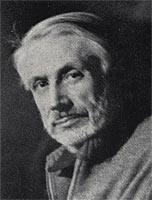
 Of Béarnaise lineage that became Parisian at the end of the 18th century, and from a line of architects, Henri Navarre was born in Paris on April 4, 1885. Initiated on construction sites by his family, architects and decorators, whom he lost early on, Alexandre, Didier and Valentin Navarre were his teachers.
Of Béarnaise lineage that became Parisian at the end of the 18th century, and from a line of architects, Henri Navarre was born in Paris on April 4, 1885. Initiated on construction sites by his family, architects and decorators, whom he lost early on, Alexandre, Didier and Valentin Navarre were his teachers.
- In 1902, he was a wood sculptor at the Bernard Palissy School, a chiseller, goldsmith, and art worker. In 1905, he was admitted to the National Superior School of Fine Arts from which he deviated to seek technical education at the Conservatory of Arts and Crafts (Lucien Magne's workshop). He studied stained glass and mosaic there.
- From 1906 to 1911, he practised stone carving on building facades, modelling large figures in terracotta.
- In 1911, he took part in the Rome competition as a medallist; in 1922, he participated in the Pointe de la Grave Monument;
- in 1923, he executed the Guynemer one;
- in 1924, he did the sculptures and stained glass windows for "L'Intransigeant";
- in 1925, the bas-relief of the Trades for the honor gate of the Exhibition;
- in 1926, the stage pediment of the Michodière Theatre;
- in 1927, the glass Christ for the chapel of "Ile-de-France";
- in 1934, the bust of Alain;
- in 1936, bronze Christ for the abbey of Saint-Benoît-sur-Loire;
- in 1938, a large vase for the French Pavilion at the New York Exhibition;
- from 1940-44, he explored the use of Sologne brick clay, which led to the "Porch of the Beatitudes" in Montargis;
- in 1950, a glass door for the Mint in collaboration with Jacques Dumond.
Henri Navarre, a member of the Autumn Salon and the Society of Decorative Artists, of which he is vice-president, is a member of the jury of the National Superior School of Fine Arts, the Rome competition, and the Superior Council of Fine Arts Education. He has been an Officer of the Legion of Honour since 1947. Goldsmith, glassmaker, medal engraver, and sculptor, Henri Navarre is, in his own way, a Renaissance man: a complete artist. Although he is of unusual culture and attracted by the philosophy of art.
"Conversations at the Sculptor's," by Alain, were written after posing sessions, this artist has a craftsman's taste for material, for the craft. "Everything comes from the hands," he asserts. His aesthetic concepts require logical means of expression, obtaining from the medium—bronze, glass, stone, or brick clay—a sensitive concordance with the idea, and it is as a sculptor that he will sign the glass vases honored in many collections.
Thus, as a medallist, he has given up the mechanical reduction of the plaster model to return to the old direct engraving in hollow of the "coin" of steel, and he has imagined his glass sculptures, not cut, but stamped, like ceramics in the mould.
By playing with all the incidences created by the fluid, living material, he obtains brilliant zones, bursts of transparency or a rough matt finish, which make each of his masks, torsos and in particular the large Christ of Ile de France a work in which the paste of the glass and the fire intimately collaborate with the artist's creative will.
An ever-alert experimenter, it was following the execution of a mural painting, a variation on Diaghilev's Ballets, that he adapted the color to the form and recognized that polychromy, thus reviving a centuries-old tradition, is the highest expression in this art.
Whether he works or conceives as a glassmaker or sculptor, Henri Navarre affirms a close dependence, a consequence of his initial training, with architecture: "No more than the fruit can be born far from the tree, take shape and flavor outside the branches and the climate of the foliage, sculpture cannot be, have life and spirit, without coming from the source of architecture."
Sources : Mobilier et Decoration N° 1 de 1954